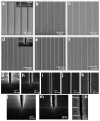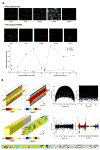Thermoplastic nanofluidic devices for biomedical applications
- PMID: 28009883
- PMCID: PMC5285477
- DOI: 10.1039/c6lc01173j
Thermoplastic nanofluidic devices for biomedical applications
Abstract
Microfluidics is now moving into a developmental stage where basic discoveries are being transitioned into the commercial sector so that these discoveries can affect, for example, healthcare. Thus, high production rate microfabrication technologies, such as thermal embossing and/or injection molding, are being used to produce low-cost consumables appropriate for commercial applications. Based on recent reports, it is clear that nanofluidics offers some attractive process capabilities that may provide unique venues for biomolecular analyses that cannot be realized at the microscale. Thus, it would be attractive to consider early in the developmental cycle of nanofluidics production pipelines that can generate devices possessing sub-150 nm dimensions in a high production mode and at low-cost to accommodate the commercialization of this exciting technology. Recently, functional sub-150 nm thermoplastic nanofluidic devices have been reported that can provide high process yield rates, which can enable commercial translation of nanofluidics. This review presents an overview of recent advancements in the fabrication, assembly, surface modification and the characterization of thermoplastic nanofluidic devices. Also, several examples in which nanoscale phenomena have been exploited for the analysis of biomolecules are highlighted. Lastly, some general conclusions and future outlooks are presented.
Figures









Similar articles
-
Fabrication of planar nanofluidic channels in a thermoplastic by hot-embossing and thermal bonding.Lab Chip. 2007 Apr;7(4):520-2. doi: 10.1039/b616134k. Epub 2007 Jan 11. Lab Chip. 2007. PMID: 17389971
-
High process yield rates of thermoplastic nanofluidic devices using a hybrid thermal assembly technique.Lab Chip. 2015 Feb 21;15(4):1038-49. doi: 10.1039/c4lc01254b. Lab Chip. 2015. PMID: 25511610 Free PMC article.
-
Fabrication of nanofluidic biochips with nanochannels for applications in DNA analysis.Small. 2012 Sep 24;8(18):2787-801. doi: 10.1002/smll.201200240. Epub 2012 Jul 9. Small. 2012. PMID: 22778064 Review.
-
Microfluidic device fabrication by thermoplastic hot-embossing.Methods Mol Biol. 2013;949:115-23. doi: 10.1007/978-1-62703-134-9_8. Methods Mol Biol. 2013. PMID: 23329439
-
A review of nanofluidic patents.Recent Pat Nanotechnol. 2008;2(3):150-9. doi: 10.2174/187221008786369633. Recent Pat Nanotechnol. 2008. PMID: 19076049 Review.
Cited by
-
A review on microscale polymerase chain reaction based methods in molecular diagnosis, and future prospects for the fabrication of fully integrated portable biomedical devices.Mikrochim Acta. 2018 May 8;185(6):285. doi: 10.1007/s00604-018-2791-9. Mikrochim Acta. 2018. PMID: 29736588 Review.
-
Glioma-on-a-Chip Models.Micromachines (Basel). 2021 Apr 26;12(5):490. doi: 10.3390/mi12050490. Micromachines (Basel). 2021. PMID: 33926127 Free PMC article.
-
Bibliometric study of plastics microfluidic chip from 1994 to 2022: A review.Heliyon. 2025 Jan 20;11(2):e42102. doi: 10.1016/j.heliyon.2025.e42102. eCollection 2025 Jan 30. Heliyon. 2025. PMID: 39906818 Free PMC article. Review.
-
Processes for the 3D Printing of Hydrodynamic Flow-Focusing Devices.Micromachines (Basel). 2023 Jul 7;14(7):1388. doi: 10.3390/mi14071388. Micromachines (Basel). 2023. PMID: 37512699 Free PMC article.
-
Electrokinetic transport properties of deoxynucleotide monophosphates (dNMPs) through thermoplastic nanochannels.Anal Chim Acta. 2018 Oct 16;1027:67-75. doi: 10.1016/j.aca.2018.04.047. Epub 2018 Apr 21. Anal Chim Acta. 2018. PMID: 29866271 Free PMC article.
References
Publication types
MeSH terms
Substances
Grants and funding
LinkOut - more resources
Full Text Sources
Other Literature Sources

